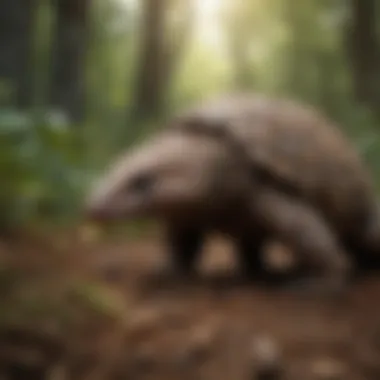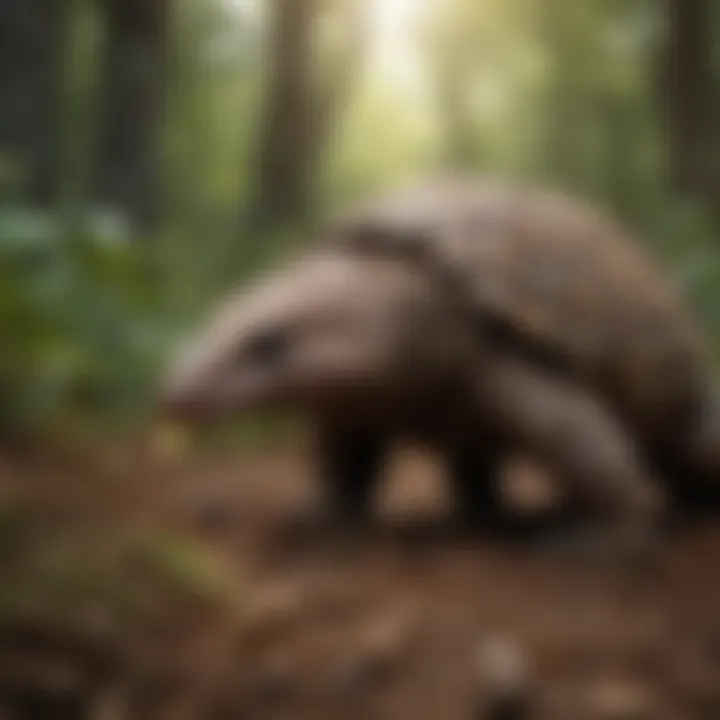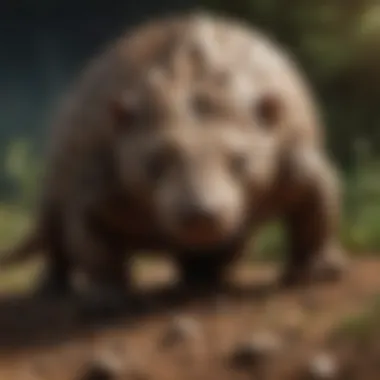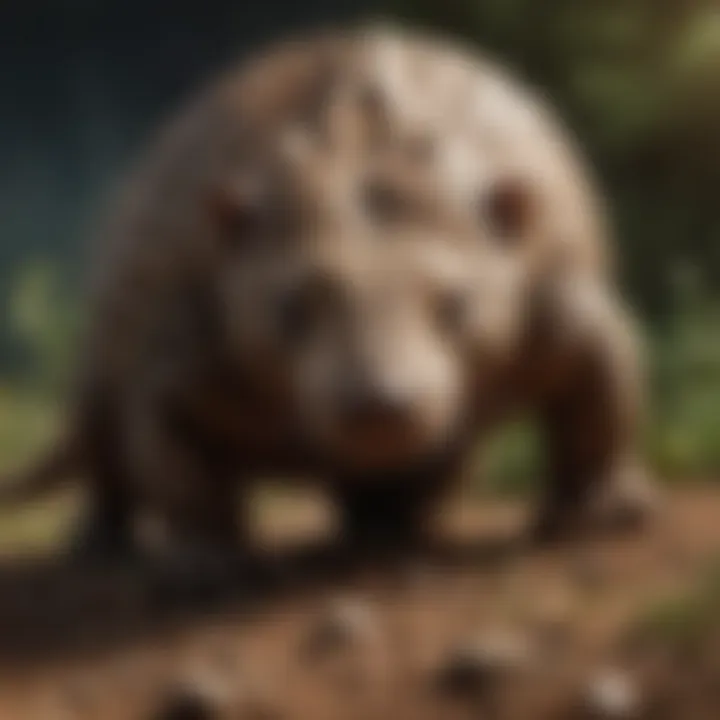Exploring the Origins and Ecology of Pangolins


Background and Context
Pangolins, often referred to as scaly anteaters, trace their story back through the intricate tapestry of Earth's evolutionary history. These unique mammals, belonging to the order Pholidota, have captured the interest of researchers due to their distinct characteristics and adaptive strategies. Living primarily in parts of Asia and Africa, they play a vital role in maintaining the health of ecosystems by controlling insect populations.
The geographical distribution of pangolins paints an interesting picture. From the dense jungles of the Congo Basin to the dry forests of Southeast Asia, these creatures have adapted remarkably to their environments. Understanding their origins is not just a matter of tracing physical traits; it requires delving into their historical relationships with other species and the environmental changes that shaped those relationships.
Historically, pangolins were not always under such threat. They existed in harmony with their habitats and were numerous across continents. However, the advent of human activities increasingly altered their fate. The rise in poaching for illegal wildlife trade and habitat destruction, primarily due to deforestation for agriculture or urban development, has turned them into one of the most endangered mammals in the world.
Key Findings and Discussion
Major Results of the Study
Through extensive research, various key findings have emerged regarding pangolins. These findings highlight not only their ecological significance but also the urgent conservation challenges they face:
- Diversity of Species: There are eight recognized species of pangolins, each exhibiting unique adaptations suited to different habitats and climatic conditions. The Chinese pangolin, for instance, has been particularly affected by illegal hunting, leading to plummeting populations.
- Evolutionary Insights: Genetic studies show that pangolins share a distant common ancestor with carnivorans, such as dogs and cats. This evolutionary link provides important insights into their development over millions of years and how they have diverged in response to environmental pressures.
- Ecosystem Role: Pangolins fulfil a crucial role in their ecosystems, acting as natural pest controllers. By consuming ants and termites, they help maintain a balance, preventing these insect populations from exploding, which could lead to significant ecological imbalance.
Detailed Analysis of Findings
In discussing the threats pangolins face, it becomes painful evident how intertwined their survival is with human actions. A significant contributor to their decline is poaching, primarily driven by demand for their scales and meat in traditional medicine markets across Asia. What's alarming is the rate at which these practices have escalated; in some regions, pangolin population numbers have decreased by over 90% in just a few decades.
"The pangolin is the most trafficked mammal in the world, a grim title that reflects the dire situation it faces."
Conservation efforts have gained traction in recent years, with various organizations advocating for stricter penalties for poaching and greater awareness regarding the ecological importance of pangolins. Initiatives to protect habitats and promote sustainable practices are gaining support, but the road to recovery for pangolins remains fraught with challenges.
Their story, much like a double-edged sword, reveals both their extraordinary adaptability and the existential threats brought on by human activity. We stand at a crossroads where immediate action is necessary to protect these fascinating creatures and preserve the delicate balance of their ecosystems.
Prelims to Pangolins
Pangolins, often referred to as scaly anteaters, are among the most fascinating yet underappreciated creatures on our planet. Understanding these unique mammals is not just about recognizing their distinct physical attributes; it's also about acknowledging their vital role in ecosystems and confronting the challenges they face. This section aims to set the stage for a comprehensive exploration of pangolins, shedding light on their definition and cultural significance, which often goes unnoticed amidst the broader wildlife conservation narratives.
Defining Pangolins
Pangolins belong to the order Pholidota and are easily identifiable due to their armor of hard, protective scales made from keratin—the same protein that forms human nails and hair. There are eight species of pangolins spread across Africa and Asia, each exhibiting unique behaviors and adaptations to their specific habitats. They primarily feed on ants and termites, using their long, sticky tongues to extract these insects from their burrows.
Notably, pangolins can roll into a tight ball when threatened, a behavior that offers them protection against predators. This defining characteristic, alongside their unique feeding habits, places them within the broader context of ecological dynamics, making them essential players in controlling insect populations.
The plight of pangolins extends beyond their intriguing biology. Their scales are highly valued in traditional medicine and as status symbols. Unfortunately, this demand has driven them to the brink of extinction in many areas, making their classification and understanding of their origins crucial in enhancing conservation efforts.
Cultural Significance
The cultural significance of pangolins is multifaceted, transcending geographical and social boundaries. In many cultures, these creatures are viewed through a lens of reverence and myth. For instance, in certain African traditions, pangolins are seen as symbols of moral integrity, often associated with healing and protection. Conversely, in some Asian cultures, their scales are believed to have medicinal properties, leading to a troubling rise in poaching activities.
"Pangolins are not just animals; they embody the cultural narratives of resilience and prosperity that various communities hold dear."
Understanding these cultural perceptions is paramount, as they drive the attitudes towards conservation and protection efforts. Without addressing the cultural facets tied to pangolins, it becomes challenging to foster community involvement in their preservation. Thus, recognizing the layers of meaning attributed to pangolins can enrich our dialogue surrounding their conservation and ecological importance.
The narrative surrounding pangolins calls for a nuanced understanding of these creatures, blending their biological characteristics with the rich tapestry of cultural beliefs that shape human interactions with the natural world. As we move to the next section, the aim will be to highlight their geographical distribution and the habitats that have shaped their evolutionary paths.
Geographical Distribution of Pangolins
Understanding the geographical distribution of pangolins is crucial for grasping their ecological roles and the conservation efforts needed to protect them. Their habitats span across two major continents: Africa and Asia, each presenting a unique set of challenges and contexts for these fascinating creatures. Recognizing the specific environments where pangolins thrive helps illuminate their evolutionary pathways and interactions within diverse ecosystems. By examining these regions, we draw attention to the specific threats they face, especially in terms of illegal trade and habitat loss, highlighting the urgent need for targeted conservation actions.
Continental Habitats
Africa
When discussing pangolins in Africa, one can't overlook the rich biodiversity found in this continent. Africa is home to several species of pangolins, primarily the Black-Bellied and White-Bellied Pangolin. The varied ecosystems, ranging from dense rainforests to dry savannas, contribute significantly to the ecological diversity found here. Notably, Africa's key characteristic is its vast and often intact wilderness areas, which foster healthy populations of the insects that pangolins rely on, such as ants and termites.
The unique feature of its complex ecosystems creates numerous niches for pangolins. However, the downside is the increasing anthropogenic pressures. Deforestation and human encroachment are rapidly shrinking their habitats, leading to a decline in their numbers. Without concerted efforts towards sustainable forest management and habitat protection, the future for African pangolins looks grim.
Asia
Asia presents a different landscape for pangolins, specifically the Indian and Chinese Pangolins among others. One striking aspect of Asia is the varying climates from the tropical forests of Southeast Asia to the temperate regions of India. This diversity enables pangolins to adapt to different environmental conditions, making them quite versatile.
The key characteristic of Asia lies in its dense human population and the consequent habitat fragmentation. Urbanization and agriculture have not only reduced available habitats but also increased direct threats from poaching. The unique feature about Asia is the demand for pangolin scales fueled by traditional medicine practices, which aggravates their risk of extinction. Hence, while Asia’s ecological richness provides potential shelters for these pangolins, the mounting pressures pose significant threats to their survival.
Specific Regions of Interest
Sub-Saharan Africa
Sub-Saharan Africa is a region of considerable ecological importance for pangolins. Here, one can find a variety of habitats that support multiple pangolin species. The distinct climate variations contribute to high insect population densities which are the primary food source for pangolins.
So, why is Sub-Saharan Africa a popular choice for this discussion? It offers insights into some of the most critical ecosystems of the continent. The unique feature of its open grasslands and dense forests provides a microcosm of the biodiversity where pangolins fit as essential players. The advantages of studying this region lie in its ongoing conservation projects, which show promise in fostering pangolin population recovery through community engagement and education.


Southeast Asia
Moving over to Southeast Asia, this region serves as a hotspot for pangolin activities, hosting several species such as the Philippine Pangolin. The lush tropical forests here create an environment ripe for insect proliferation, ideal for pangolins. One distinctive aspect of Southeast Asia is its complex interwoven cultural connections with wildlife.
However, the intensity of illegal wildlife trade is particularly pronounced in Southeast Asia. The unique feature of its illegal markets is alarming; they often overshadow the ecological significance of pangolins. It provides a case study in how conservation challenges can arise from cultural practices and economic factors. Strategies tailored to the Southeast Asian context must target both wildlife protection and educational outreach to change perceptions about pangolins.
South Asia
In South Asia, particularly India, pangolins find themselves at a critical junction. The region reflects a blend of ecosystems that provide habitat variations from dense forests to arid lands. The Indian Pangolin primarily thrives here, showcasing adaptability to diverse conditions.
South Asia's key trait of rich cultural history associated with wildlife creates pathways for potential conservation narratives. However, the unique feature of this region’s extensive agricultural land use pressures pangolin habitats, making their populations vulnerable. Efforts toward habitat preservation and awareness campaigns are vital in addressing both conservation and community livelihood interests.
"Without understanding the geographical distribution of pangolins, conservation efforts may miss the mark, as habitat loss and trade pressures become more problematic."
Thus, it is clear that each continent and specific region possess features that can help or hinder pangolins' survival. The contrasts between Africa and Asia highlight the pressing need for responsive conservation strategies, tailored to the local contexts to ensure the best chances for these unique creatures.
Species Classification
Understanding the classification of pangolins is crucial for multiple reasons. First, it sheds light on the biological diversity within the species and its various subgroups. Knowing how they fit into the broader ecological picture assists conservationists in developing effective strategies. Furthermore, species classification plays a pivotal role in recognizing the specific threats each species faces, aiding in targeted conservation efforts.
Overview of Species
Pangolins are unique mammals, often referred to as scaly anteaters, belonging to the family Pholidota. They are celebrated for their remarkable adaptations, particularly their keratinous scales, which offer them protection against predators. Each species has its distinct traits and ecological roles, which is vital to maintaining biodiversity. Understanding these subdivisions helps researchers and conservationists alike in their quest to protect these fascinating creatures.
The Eight Species
Indian Pangolin
The Indian Pangolin stands out due to its distinctive features, such as large overlapping scales that cover its body, providing both a striking appearance and vital protection. This species thrives in a variety of habitats, from grasslands to forests. Its primary contribution to our understanding of pangolins revolves around its feeding habits, which involve a diet predominantly of ants and termites. This specialized diet indicates its role in regulating insect populations in its environment, making it a crucial player in ecosystem balance. However, the Indian Pangolin faces significant threats from poaching driven by demand for its scales and meat, making it imperative to prioritize its conservation.
Chinese Pangolin
The Chinese Pangolin is noted for its smaller size and narrower plates compared to other species. Its geographical range stretches across many provinces in China and into parts of Southeast Asia. As a significant contributor to the ecosystem, the Chinese Pangolin helps maintain ant and termite populations, thereby influencing soil health. Its scales have been historically prized in traditional medicine, deepening the urgency of conservation. The unfortunate reality is that its popularity has put it on the brink of extinction, highlighting the dire need for protective measures and legal frameworks.
Black-Bellied Pangolin
With a distinctive black belly, the Black-Bellied Pangolin is primarily found in the rainforests of Central and West Africa. Its robust build and nocturnal behavior set it apart from others. This species is vital as it serves as an efficient forager, consuming vast amounts of ants and termites daily. The unique feature of its ability to dig deep into the ground makes it particularly adept at reaching food sources that other species cannot. Unfortunately, it faces threats from illegal hunting and habitat loss, which necessitates immediate attention for its conservation status.
White-Bellied Pangolin
The White-Bellied Pangolin showcases a striking contrast between its white belly and darker scales. Found mainly in the forests of Central Africa, it plays a significant ecological role similar to its relatives. This species’ dietary preferences indicate its importance in pest control within its native habitat. The urgency of researching its behavior and population dynamics cannot be overstated due to ongoing threats from deforestation and poaching for the illegal wildlife trade.
Philippine Pangolin
The Philippine Pangolin is unique to the Philippine archipelago, showcasing distinct features adapted to island life. It has a diet closely aligned with insectivorous foraging methods, feeding mainly on ants. This species is critical to its environment, as it shapes the population dynamics of its prey. Moreover, its limited distribution makes it particularly vulnerable to extinction, underscoring the need for targeted conservation efforts and protective measures in the region.
Ground Pangolin
The Ground Pangolin is a burrowing species often found in grasslands. Adapted for life on the ground, it has powerful claws that enable it to dig. Its primary contribution is its extensive burrowing behavior, which aerates the soil and contributes to the ecosystem's health. However, its reliance on specific habitats makes it susceptible to environmental changes and human encroachment, requiring urgent conservation efforts to ensure its survival.
Temminck's Pangolin
Recognized for its size and range, Temminck's Pangolin inhabits a variety of countries in Africa. Its unique adaptability to various environments demonstrates its ecological versatility. This species has a critical role in managing insect populations and, consequently, in maintaining ecological balance. Yet, the threats it faces from poaching and habitat destruction demand immediate conservation strategies if we hope to see this species thrive in the wild again.
Giant Pangolin
The Giant Pangolin is the largest of the eight species, with considerable size and distinct features. Found primarily in the tropical hardwood forests of Central and West Africa, it represents a critical element of its ecosystem, consuming large quantities of termites. Its significant ecological contribution makes it a priority for conservation efforts. Sadly, the Giant Pangolin is highly sought after in the illegal wildlife trade, signaling the necessity for stronger protective measures and awareness campaigns to mitigate the threats surrounding its survival.
"Pangolins play a pivotal role in their ecosystems, both as consumers and as prey, emphasizing the need for concerted conservation efforts."
In summary, understanding the various species of pangolins enriches our overall comprehension of their ecological roles and the pressing issues they face. Each species presents unique opportunities and challenges, making concerted conservation efforts paramount for their survival.
Physical and Behavioral Characteristics
Understanding the physical and behavioral characteristics of pangolins sheds light on their unique adaptations to their environment, revealing the ways they thrive despite various pressures. This section delves into two main areas: their distinctive anatomical features and the behaviors that help them navigate and survive in their habitats. The interplay between physical traits and behavioral patterns not only defines pangolins but also highlights their ecological role and the challenges they face.
Distinctive Features
Scales and Armor
Pangolins are often recognized for their remarkable armor-like scales, a primary defense mechanism against predators. Made of keratin, the same material found in human nails and hair, these scales cover their bodies from head to tail. One might think of them as nature's own version of armor plating, offering substantial protection.
The thick, overlapping scales provide a sturdy barrier against threats and serve to deter potential attackers. When threatened, pangolins can roll into a tight ball, with these scales acting as a shield. This trait is crucial, especially in environments where wildlife interactions are frequent.


While the scales are effective against most predators, they also pose certain disadvantages. The very feature that provides defense hinders movement through dense vegetation as they can get caught and snagged. Moreover, the illegal trade of pangolin scales for traditional medicine poses a significant threat to their survival.
Claw Adaptations
Pangolins possess large, curved claws that are perfectly tailored for digging. This characteristic is essential for their foraging behaviors, as their primary diet consists of ants and termites. Their claws enable them to excavate nests with impressive efficiency, allowing them to access their food sources hidden beneath hard earth.
Another key feature of these claws is their role in climbing. Some pangolin species are arboreal, which means they spend a significant time in trees. Their strong claws help them cling to branches and navigate their woodland habitats adeptly. However, the adaptation for digging can create challenges; excessive digging can lead to habitat degradation if populations become too dense.
Behavioral Patterns
Feeding Habits
Pangolins are nocturnal creatures, primarily active during the night. Their feeding habits are specialized; they have long, sticky tongues that allow them to extract insects from their nests effectively. A pangolin can consume up to 70 million ants and termites annually, which underscores their role in controlling insect populations.
The behavioral aspect of their foraging is a dance of adaptation. They can sense the vibrations of insects in the ground, which guides them to their next meal. This unique hunting style not only speaks to their evolutionary development but also emphasizes their importance in maintaining ecological balance.
However, their focus on termites and ants makes them vulnerable to changes in habitat, particularly as deforestation encroaches on their foraging grounds.
Nesting and Dens
When it comes to nesting, pangolins exhibit fascinating behaviors. They often choose to dig burrows or utilize existing ones, creating a safe space for resting and rearing offspring. Their choice in nesting sites is typically influenced by their habitat's safety and availability of food.
Some pangolins will also line their dens with leaves and grass, helping to insulate and camouflage them from potential threats. This attention to nesting quality reflects their instinct to safeguard their young and themselves. However, with habitat destruction ongoing, suitable nesting sites are becoming scarcer, threatening their survival.
Social Behavior
Pangolins are primarily solitary animals. Most species prefer to live alone, coming together only during mating seasons or when a mother raises her young. This solitary nature influences their social structures and interaction with the environment.
Interestingly, however, some pangolin species do display social interactions during feeding. They may tolerate each other's presence around an abundant food source, revealing aspects of social flexibility. Yet, this behavior also comes with risks; increased interactions can lead to competition or territorial disputes, becoming an area of concern as populations shrink.
"Pangolins, with their unique features and adaptive behaviors, are essential to the ecological balance, yet they face significant challenges that threaten their existence."
Physical and behavioral characteristics of pangolins not only define their existence but also underscore their vulnerabilities. Understanding these traits provides essential knowledge critical to their conservation, which is paramount in the face of escalating threats. The exploration of their characteristics invites a deeper appreciation for the delicate balance they maintain within their ecosystems.
Ecological Role of Pangolins
Pangolins hold a unique position within their ecosystems, functioning as vital agents that contribute to ecological balance. Their role goes beyond being mere inhabitants of their habitats; they actively shape the dynamics of their environments. One of the remarkable aspects of pangolins is their impact on soil health and insect populations, particularly ants and termites, which are integral to many ecosystems. Through their burrowing and feeding activities, pangolins help aerate the soil and recycle nutrients, thus supporting plant growth and overall biodiversity. Understanding the ecological role of pangolins is essential, especially in the context of their conservation.
Pangolins as Ecosystem Engineers
Impact on Ant and Termite Populations
Pangolins are often referred to as ecosystem engineers due to their significant influence on ant and termite populations. By consuming these insects in large quantities—up to 70 million ants or termites per year—pangolins naturally regulate their populations. This predation is crucial because it prevents overpopulation, which can disrupt other species and the ecological balance. When pangolins forage, they disturb the soil and vegetation, which can enhance local biodiversity by allowing new plant species to thrive and providing habitats for various animals.
The key characteristic of pangolins in this capacity is their specialized feeding habits. They have long, sticky tongues designed for extracting ants and termites from their nests. This unique feature not only facilitates their survival but also signifies their importance in maintaining healthy ecosystems. Their foraging behavior creates opportunities for other species by exposing insects and dispersing seeds, fortifying the whole food web.
Interactions with Other Species
Predators and Companions
The interactions that pangolins have with other species are diverse and essential for maintaining ecological integrity. They serve as prey for larger predators, such as leopards and lions, which depend on pangolins as part of their diet. This predator-prey relationship is significant as it contributes to the food chain and influences various ecological processes.
What’s interesting is that pangolins also coexist with other animals like birds and small mammals in their habitats. The presence of these creatures often creates a balanced environment where species depend on one another. For instance, while pangolins dig for insects, they inadvertently create habitats for other animals, demonstrating a unique characteristic of mutualism in their ecosystem.
"If we lose pangolins, we lose a key player in our ecosystems, and it’s a domino effect that can lead to much larger ecological issues."
This focus on the ecological importance of pangolins sheds light on the broader implications of their endangerment, reminding us of the intricate linkages within nature that sustain life.
Threats to Pangolin Populations
As intriguing as pangolins are, their existence is hanging by a thread, facing an array of menacing threats. The journey into understanding these magnificent creatures cannot overlook the discussion about their populations and the critical challenges they confront. From rampant poaching to widespread habitat destruction, the factors jeopardizing pangolins are not only dire for them but also tell a broader story about our ecological health. Addressing these threats is paramount in effective conservation strategies, as it sheds light on the interventions needed to safeguard their future.
Poaching and Illegal Trade
In the spotlight of endangered species, pangolins hold the unfortunate title of being the most trafficked mammal globally. This is primarily rooted in their scales, which are wrongly believed to have medicinal properties and are in constant demand in traditional Asian medicine. It’s a bit like a wild goose chase; these myths lead to a flourishing black market that sees pangolins snatched from their natural habitats in alarming numbers.
There’s not just one pangolin getting hurt here but an entire web of ecosystems is impacted by such practices. As noted by various wildlife organizations, an estimated one million pangolins have been poached over the last decade. When such numbers come to light, it becomes clear that this isn’t merely a problem for pangolins, but an urgent global situation, implicating biodiversity loss and habitat degradation. The poaching operations can be quite organized, with syndicates operating across borders. The sheer scale of illegal trade adds another layer of difficulty to already beleaguered conservation efforts.
"If there is anything we can learn from the pangolin crisis, it's that protecting one species requires attention to the myriad of human factors entwined in ecological health."
Habitat Destruction
Equally concerning is the rampant habitat destruction that pangolins are facing. Deforestation, driven by agriculture and urbanization, gnaws away at their homes. As forests fall to the axe, pangolins lose their crucial habitat, which not only includes their homes but also their food sources— ants and termites. Without this habitat, they can find it hard to survive; it's akin to pulling the rug out from under them.


In Asia, for instance, the demand for land for various purposes leads to the loss of woodlands that serve as vital shelters for pangolins. The unsustainable agricultural practices and urban sprawl wreak havoc, leading to fragmented landscapes that make it difficult for these creatures to thrive. Increasingly, pangolins are left scurrying across roads or finding shelter in unsuitable areas, which, let’s be honest, isn’t the best living arrangement!
The loss of biodiversity tied to habitat destruction cannot be overstated. The decline of one species, like the pangolin, can send tremors through the ecosystem, impacting numerous upcoming generations of plants and animals. To truly comprehend the plight of pangolins is to understand that their fate signifies critical cues about our environment's overall health.
When it comes to conserving these peculiar mammals, it ultimately rests on our shoulders to change our habits and societal values regarding wildlife. The survival of pangolins is entwined with changes in poaching practices and stricter regulations around habitat conservation.
Indian pangolin, Chinese pangolin, and the rest of their kin deserve every bit of effort we can muster to ensure that their species lives on.
Ultimately, the survival of pangolins is an urgent call for awareness and action within our global community.
Conservation Efforts
Conservation is a vital discussion point when it comes to pangolins, these scaly marvels facing extreme threats due to poaching and habitat loss. The savior's call hinges on multifaceted conservation strategies aimed at not only preserving these species but also restoring their habitats. Engaging global initiatives and local community efforts creates a framework that may help to secure a lasting future for pangolins. To really pin down what works, it's important to dissect these operations, looking closely at laws that protect the species and the role of education in impactful outreach.
Global Initiatives
Legal Protections
Legal protections serve as a backbone for the conservation of pangolins. They provide a critical framework that discourages illegal trade and hunting activities. Countries around the world have come together to craft legislation that makes pangolin trafficking a criminal offense, ensuring that offenders face severe penalties.
A key characteristic of these protections is the high penalty attached to trafficking offenses. This hefty consequence is crucial as it tries to deter prospective wildlife criminals. Additionally, the involvement of international agreements such as CITES (Convention on International Trade in Endangered Species) adds an extra layer of scrutiny, ensuring that all nations work in concert to shield pangolins from exploitation.
However, while these legal frameworks are robust, there are unique challenges. Enforcing these laws in remote areas where poaching often happens can be daunting. Corruption and limited resources can undermine the success of such legal measures, making it imperative to have a multi-pronged approach.
Conservation Programs
Conservation programs have gained traction as effective mechanisms for safeguarding pangolin populations. These initiatives often focus on habitat restoration, anti-poaching patrols, and captive breeding programs to help bolster dwindling numbers. A key characteristic of these programs is their adaptive management strategies, allowing them to shift and evolve based on real-time observations and outcomes.
The presence of local partnerships strengthens conservation programs significantly. By working closely with communities, these programs help to raise awareness around the importance of conserving pangolin species and their habitats. One unique feature is that some initiatives offer alternative livelihoods to locals who might otherwise rely on poaching for income. This interconnectedness could be the very lifeblood of successful conservation efforts.
Yet, these programs can face limitations, particularly in funding and resources. Many conservation initiatives rely heavily on grants and donations, which may be inconsistent. This variability can lead to lapses in efforts, which could prove detrimental in the long run.
Community Involvement
Education and Outreach
Education and outreach are paramount in fostering local support for pangolin conservation. Engaging the surrounding communities through education creates awareness about the threats these creatures face. One key aspect of such initiatives is that they not only inform locals about the importance of pangolins but also empower them to take action.
Public awareness campaigns can mobilize community engagement, especially if they tackle misconceptions about pangolins often viewed as pests. Workshops, seminars, and even social media platforms serve as excellent vehicles for disseminating information. They play a beneficial role in shifting public perception, which can greatly impact conservation success.
One unique feature of these educational efforts is their potential to create long-lasting change as they instill a sense of stewardship in local populations. Nevertheless, scaling outreach initiatives remains a challenge, as resources may be limited.
Local Conservation Groups
Local conservation groups act as the grassroots lifeline for pangolin protection efforts. These organizations frequently collaborate with various stakeholders to develop localized strategies that address the pressing issues faced by pangolins in their region. A notable characteristic of these groups is their ability to adapt tactics based on deep knowledge of local cultures and practices.
Such organizations foster community pride, encouraging locals to take ownership of the conservation efforts. Their unique feature lies in their adaptability, as they can swiftly adjust their strategies based on changing circumstances. This fluidity generally stands them in good stead as they can maximize impact.
However, local conservation groups can face challenges, especially if they lack the necessary funding or resources for their initiatives. This makes it crucial for external support systems, such as NGOs and government partnerships, to ensure their sustainability.
"Working as a unit can yield energized outcomes that empower both pangolins and the communities they inhabit, ensuring a brighter future for this remarkable species."
In summary, conservation efforts geared toward pangolins are a multi-dimensional dialogue that requires legal backing, community involvement, and education. By weaving these threads together, stakeholders can strive toward a sustainable future, ensuring these unique creatures continue to thrive in their natural habitats.
Future Prospects for Pangolins
The future of pangolins hangs in the balance, with numerous factors influencing their survival and well-being. Their continued existence is pivotal not only for the creatures themselves but also for the intricate ecosystems they inhabit. Understanding the future prospects for pangolins sheds light on potential pathways for their conservation and rehabilitation in the wild.
Research and Monitoring
Ongoing research plays a vital role in protecting pangolins. Scientists are delving into various aspects of pangolin biology, ecology, and behavior to gather essential data that informs conservation strategies.
Efforts in this regard include:
- Tracking Movement: Researchers are employing advanced tracking technologies to monitor pangolin movements, which helps in understanding their habits and territory needs.
- Population Surveys: Regular surveys are critical for assessing population size and trends in different regions. This data helps to identify areas needing urgent conservation efforts.
- Behavioral Studies: Investigating feeding habits and social structures provides insights that can guide habitat management plans.
"Essential research is crucial for uncovering the myriad of questions surrounding pangolin life, leading to targeted conservation strategies."
This knowledge not only aids in developing effective protection programs but also ensures that local communities are involved in conservation efforts, reinforcing the symbiotic relationship between nature and people.
The Role of Technology in Conservation
Advancements in technology offer unprecedented opportunities for pangolin conservation. State-of-the-art tools and methods are being harnessed to battle the poaching crisis and to create a safer environment for these animals.
Some key technological interventions include:
- Camera Traps: These devices allow for non-invasive monitoring of wildlife populations and gathering data on pangolin presence in various habitats.
- Drones: Used for aerial surveys, drones can cover extensive areas, identifying potential poaching hotspots and gathering intelligence on illegal activities.
- Genetic Analysis: Understanding genetic diversity among pangolin populations helps to inform breeding programs and enhance the species’ resilience.
Each of these technological advancements offers promising avenues for pangolin conservation, ensuring that we do not lose this unique and irreplaceable part of our biodiversity. With the right combination of research, technological support, and community commitment, the prospects for pangolins can shift from grim to hopeful.







